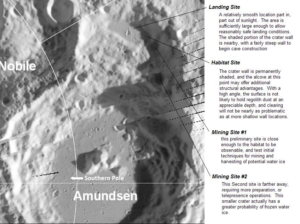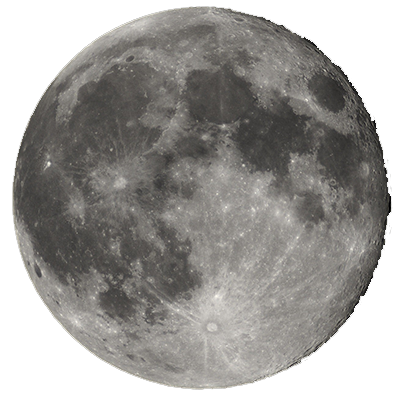Destination: Moon
The Lunar destination represents just the first step on the road to settlement of the solar system. In the same vein that Gemini was our first manned step into space, we must take our next step and learn from the experience, to take the next step after. But as we go as Settlers, sending real people to live, then more after.
Primary Goals
Specific goals across all settlements are:
- To establish a beachhead farm, that can, within its first six months, begin a) producing its own food, b) recycling its water, and c) recycling its air.
- Prove the mining techniques for futher habitat construction, and other mining needs to be fine tuned as time goes forward.
- Provide a foundation of infrastructure for economic growth of the Earth-Moon system.
- Establish a repeatable, successful methodology for habitat construction that can be applied to Mars, and beyond.
- Prepare for the arrival of the next team.
Site Selection – and the Habitat
Our initial selected site is Noble Crater, adjacent to Amundsen Crater, located off the southern pole.  Noble was chosen for several reasons:
Noble was chosen for several reasons:
- Because it was not quite as deep as Amundsen itself,
- The proximity of two deep, permanently dark smaller craters along the wall between our projected cave location and the drop into Amundsen proper.
- The shelf provides sufficient level ground for multiple craft to safely land and depart.
- The “northern’ wall rests in near permanent shadow that allows for the opportunity to research the geology of the shadowed areas.
- That shadow provides a continuous temperature range that reduces the deleterious effects of being out in the open and subject to the larger temperature extremes.
- The bulk of the rock above the cave will provide substantial protection from the various types of deadly radiation arriving from deep space..
[/tab]
[tab title=”LLO”]
Implementation of Lunar Orbit Station
During this time, other team members will be making preparations to construct a viable transportation schedule to the Lunar Station components. The first component will be the Dragon craft they all arrived in. It will be lifted to a stable orbit and begin receiviing supplies from the habitat below. As the second crew arrives, their Dragon will carry them to the surface, and when the third team arrives and lands, the second Dragon will join the first in orbit. One of the landers will be reconfigured as a lunar transit cargo hauler, and dispatched to lunar orbit for preparation to return to earth orbit.
One scenario to facilitate the transit of discarded ships from the ISS is that the cargo craft arrive with sufficient fuel for the return trip to the moon, pushing the Soyuz, ATV, HLN, other components that would otherwise be thrown into the atmosphere. That cargo “booster” would facilitate the assembly of a larger, roomier Mars Settlement craft literally as fast as the craft can be transited to the lunar orbit.
By the time the fourth Lunar Mission 0 team arrives our settlement will comprise the following minimum inventory:
| On the surface | In Lunar Orbit |
|---|---|
| 24 Persons in 4 cave-habitats | 4 persons rotating from surface each month |
| One Dragon Craft | Three Dragon Craft |
| 4 cargo landers | 4 cargo landers |
| Fish and fishpond | At least 8 Soyuz craft |
| Chickens and composting insects | 2 ATV cargo craft |
| Various Crops, One fledgling Bamboo forest | 2 HLN cargo craft |
Possible enhancements to the orbital component:
- Four 6-port universal docking modules
- One Bigelow module
- Four Vasimir Plasma Propulsion Modules
- One 800 kw nuclear power plant
These enhancements are necessary to provide for the most efficient transit from lunar orbit to Mars orbit.
[/tab]
[/tabs]
Establishing Trade
As technological components and personnel shipments will be able to increase, unburdened by air, food, water, and eventually fuel, the ISS, Tiangong, and other orbital outposts can focus on receiving people, increasing their crew complement, or just providing through-transit facilities for the settlers that will begin flowing as the lunar settlement becomes viable.
With the beginnings of trade between the Earth-orbiting stations and the lunar settlement, the assembly of the Mars Settlement Ship can move forward, providing impetus for the increase in launch frequency necessary for the nascent launch industry to begin to reduce launch costs to further facilitate the movement of settlers into the vast frontier of space.
The ultimate purpose of the Lunar Settlement is not to just put people there and quit. It is rather to put people there, send more people to live there, and then begin sending people to travel through there on the way to settle Mars. Let’s not disappoint our children!
